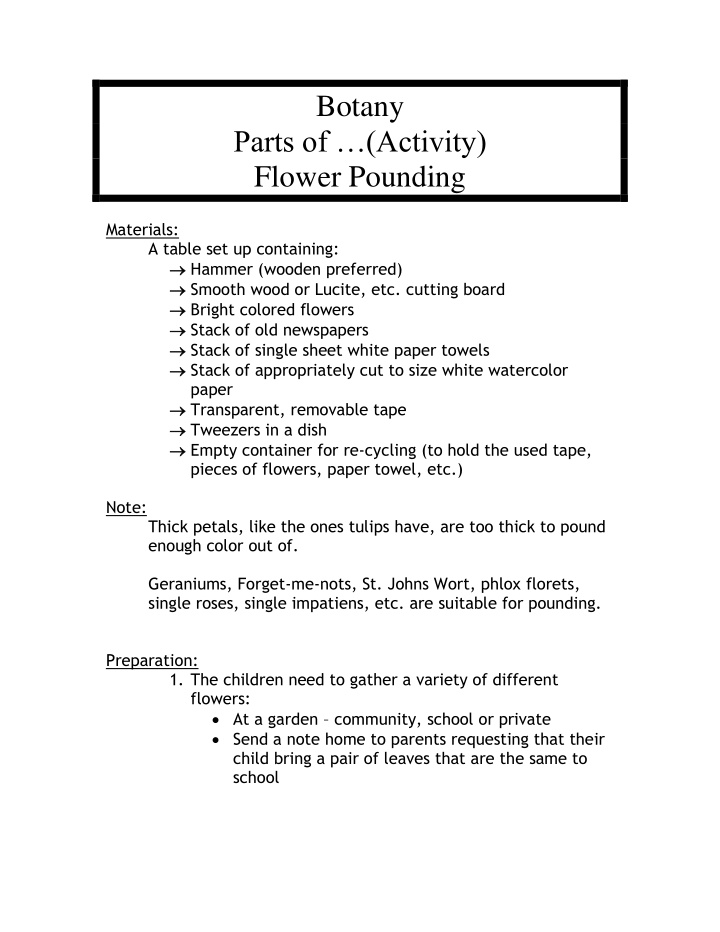



Botany Parts of …(Activity) Flower Pounding Materials: A table set up containing: Hammer (wooden preferred) Smooth wood or Lucite, etc. cutting board Bright colored flowers Stack of old newspapers Stack of single sheet white paper towels Stack of appropriately cut to size white watercolor paper Transparent, removable tape Tweezers in a dish Empty container for re-cycling (to hold the used tape, pieces of flowers, paper towel, etc.) Note: Thick petals, like the ones tulips have, are too thick to pound enough color out of. Geraniums, Forget-me-nots, St. Johns Wort, phlox florets, single roses, single impatiens, etc. are suitable for pounding. Preparation: 1. The children need to gather a variety of different flowers: At a garden – community, school or private Send a note home to parents requesting that their child bring a pair of leaves that are the same to school
Presentation: 1. Invite the children to join you for a circle presentation. 2. Explain to the children that today you are going to make a pretty picture by pounding flowers . 3. Invite the children to follow you over to the art table where the Pounding Flowers activity is set up. 4. The teacher should place the cutting board on top of the stack of newspapers. 5. The teacher should place a piece of white paper towel on top of the cutting board. 6. The teacher should place a piece of the watercolor paper on top of the paper towel. 7. Now, the teacher should choose a flower from the flower basket and gently lay it down on top of the watercolor paper. 8. The teacher takes the tape and secures the flower to the paper. 9. The teacher takes the hammer and gently pounds the flower. 10. The teacher puts the hammer down and carefully removes the tape from the flower. Both the tape and the pieces of the flower goes into the empty container on the table. 11. The teacher uses the tweezers to remove any pieces of the flower that may have stuck to the paper. 12. Now the teacher takes the flower printed paper and holds it up. After she pauses to look at she says, “I love the print that my flower pounding made!” 13. The teacher says, “Now I will sign my art work and place it on the shelf until it is time to take it home (or put it up on the wall, etc.)”. 14. Next, the teacher takes her used paper towel and places it in the recycling container that is on the table. 15. The teacher finally replaces the cutting board, hammer, tweezers, tape, etc. to where they were before she began. 16. When the teacher is finished she says, “Now the flower pounding activity is ready for someone else to do. I hope each one of you take a turn at making a picture!”
Variations and Extensions: 1. Take the petals off and pound each one 2. Make a picture using different flowers 3. Make a picture using flowers and leaves Points of Interest: 1. How the color of the petals look on the paper 2. How some petals are easier to get color from Control of Error: 1. You may make a control card with pictures or drawings that show the different steps in order. 2. You may put numbers next to each item in the order they are to be used. Aims: To be introduced to the fact that flowers are a delight to our eyes when we see them in our garden, on our tables, and in the artwork we make! To be introduced to the basic parts of a flower. Age: 2 ½ and up Language: Names of the parts of a flower, names of the colors of the flowers, etc.
Recommend
More recommend